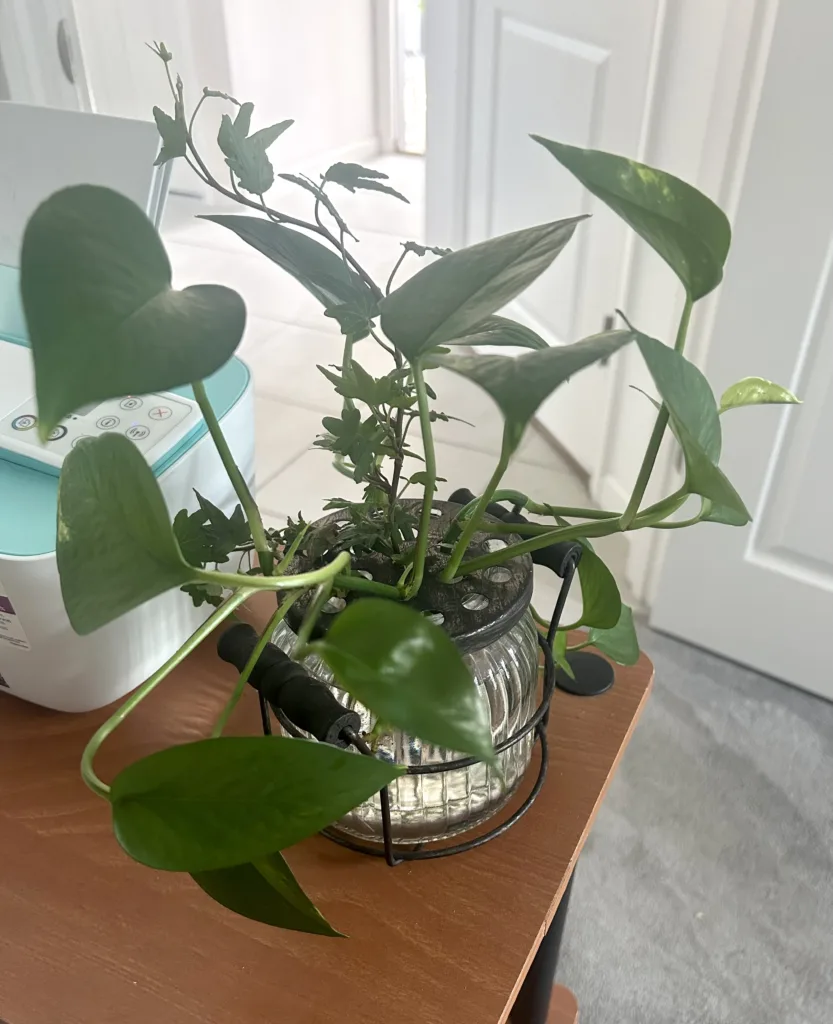If you’re a plant lover, you’ve likely heard of the moonlight pothos. This striking houseplant with its green and yellow leaves adds color and life to any indoor space. The moonlight pothos, also known as Epipremnum Aureum ‘Moonlight,’ is one of the most popular species of pothos. This tropical plant is easy to care for, making it an excellent choice for beginners. In this post, we’ll cover everything you need to know about growing and caring for a moonlight pothos, including soil and potting, lighting, watering, and propagation.
Pot and Soil type for your Moonlight Pothos
Choosing the right pot type and soil type is crucial to the health and growth of your moonlight pothos. For pots, you should select a container that has drainage holes to avoid stagnant water around the roots. Opt for a plastic or terra cotta pot over a glass or metal one as it can retain too much moisture. I also like to have some of my pothos in one of the many pot head planters, they add allot of character and make me smile every time I see it. Concerning soil, your moonlight pothos will thrive in a well-draining potting mix with a pH level of 6.5 to 7.5. A good potting mix includes a combination of peat moss, perlite, and sand.
Light and Water Requirements
Moonlight pothos needs enough light to grow but not direct sunlight. It prefers bright but filtered natural light or fluorescent light. It’s important to place the plant within 6 to 8 feet of a window, avoiding direct exposure to the sun to avoid scorching the leaves. You can also grow them under LED grow lights if you don’t have the perfect window. Proper watering is also important for a healthy moonlight pothos. They prefer their soil to be moist but not waterlogged, so you should water your plant once every one to two weeks. Always check the soil’s moisture level before watering and consider using rainwater if possible for healthier growth.
Growing Pothos Hydroponically

If you enjoy gardening and experimenting with different methods, consider growing your moonlight pothos in a hydroponic system. This can be great for those who don’t want to deal with soil or pots, or for those who are looking to get creative with their pothos growth. I have stems from a few different pothos along with some ivy in a unique vase in my office that has been growing in water for around 6 months now. It adds the perfect touch of green to my desk area.
Fertilizing your Pothos
Moonlight pothos grows fast, so fertilization is an essential part of plant care. To ensure proper growth and health, fertilize your plant every month using a well-balanced fertilizer during the growing season of spring and summer. During spring and summer, the plant has higher growth and produces new leaves, so it is necessary to provide extra nutrients to support its growth. You can reduce fertilizer applications during the winter as this is the time when the plant is dormant.
Propagating Moonlight Pothos
Propagating moonlight pothos is easy and you can do it in various ways, including water propagation, soil propagation, and air layering. Water propagation is the easiest method that involves cutting off a stem with two to three nodes from the mother plant and placing it in water in a propagation station until roots develop. Once it roots, you can plant the cutting in soil. Soil propagation is done by placing the cutting in soil and keeping it humid for quick rooting. Air layering is another method, where a section of the plant’s stem is removed, treated with rooting hormone, and enclosed in a moistened moss until it develops roots.
Happy Gardening!
In conclusion, the moonlight pothos is a beautiful and easy-to-care-for houseplant. By following the guidelines mentioned above, you can grow and maintain a healthy plant. Choose the right pot type and soil mix, provide appropriate lighting and water, and fertilize the plant regularly during the growing season. If you want to propagate it, try using one of the different methods we’ve covered. Growing a moonlight pothos is a fulfilling experience and one that you’ll likely enjoy for years to come.
Please be sure to check out my Gardening Blog Post Page for more tips on all types of gardening. Including Seed Saving, Seed Starting, Orchids, Water Gardening, Coldframe Gardening, Indoor Bulb Gardening, Hydroponics, Container Gardening, Mums, Herbs, African Violets, planting Bulbs, Flower Gardening, Vegetable and Fruit Gardening, Indoor Houseplants of all kinds, Cactus, Succulents, Hanging plants, Deer resistant plants and even Bird, Bee, Butterfly and Hummingbird Gardens!
